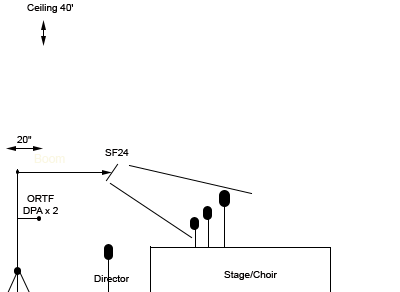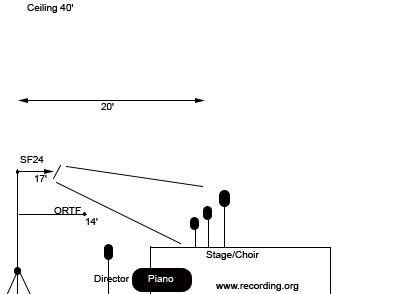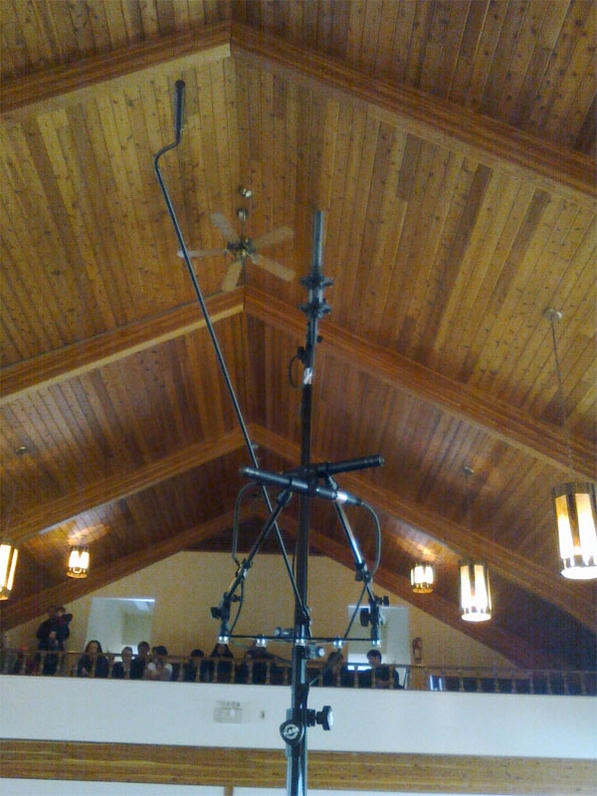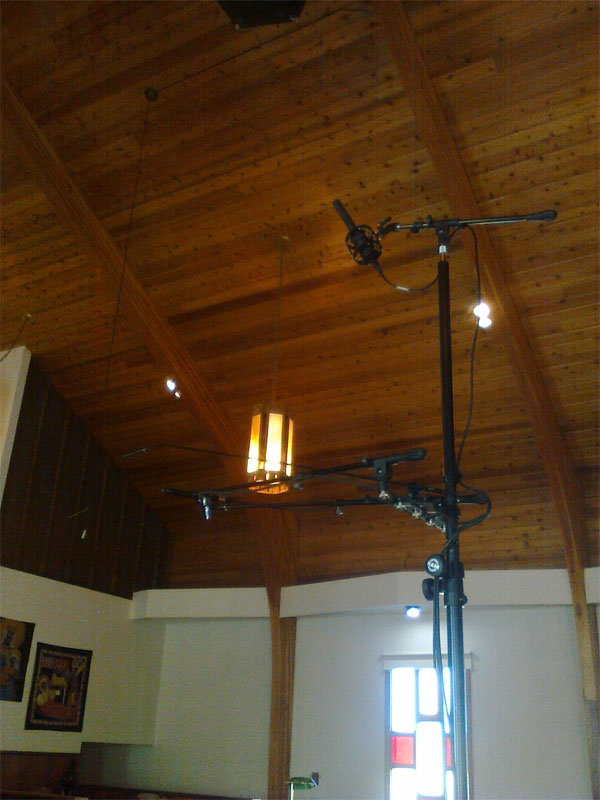I've discussed this more than once but wasn't sure what mics I'd settle on and know how the room would sound with people in it until yesterday.
Recording 14 choirs over 2 days. Largest choir will be 75 people.
Small choir test
Last week using two R-122's in Blumlein about 20 ft back from the choir, 2 ft above top head level for a test run sounded pretty nice.
The 40 ft ceilings in a barn style church make it a bit reverb heavy so what are some ways to tame this a bit?
Updates:
A Royer SF-24 arrived for me yesterday ( so nice) and am very thrilled to use this instead of my R-122's. What are some ways to improve things with limited room for one tall (with small booms if needed) stand behind the choir director?
I'm thinking if I could get a little closer with the SF24 (closer = less reverb yes but may loose the far left/right a bit?) and then put two DPA 4011A in ORTF on the stereo bar to catch the wings.
Am I on track here?
Any suggestions?
Comments
Thanks Bos, You've confirmed some insecurities and the obviou
Thanks Bos,
You've confirmed some insecurities and the obvious. I always appreciate your time you take to help me.
I haven't used the SF-24 yet but I'm sure its going to be exceptional as a stand alone, simple and balanced and why I wanted an SF for this. Where I have it is choice and I'm going to have to live with the room. erk... Everything sounds very balanced.
So, words of experience coming from within, keep it simple and do a little eq at the end of the day. Too much variables to compensate the bad room will take the simplicity and enjoyment out. I need to just have fun here. If I don't add more mics, I won't be tempted to do more than what the room really is. The key to this gig is making sure its balanced and sounds like the room they were all performed in.
My first Choir, I want it to be perfect.
Good to learn about the time delay. Why do the sides hear it first? Is that because the mics are close to the walls?
If you are talking about the SDCs on the bar up with the stereo
If you are talking about the SDCs on the bar up with the stereo ribbon, I would normally use cardioids, as that is what the ORTF pattern needs. I've not tried spaced A-B (using omni capsules) for this type of work in conjunction with a ribbon, quite apart from it looking a bit out of place in a public concert.
Boswell, post: 365773 wrote: If you are talking about the SDCs o
Boswell, post: 365773 wrote: If you are talking about the SDCs on the bar up with the stereo ribbon, I would normally use cardioids, as that is what the ORTF pattern needs. I've not tried spaced A-B (using omni capsules) for this type of work in conjunction with a ribbon, quite apart from it looking a bit out of place in a public concert.
Hi Bos,
I'm still getting familiar with some of the mobile terms. I was wondering and thinking the term "outriggers" were actual mics on stands located on the left and right sides of the venue (near the walls) and if those were omni or cardioids? Reason why... you mentioned that they picked up the sound quicker so this made me think it was because they are close to the walls. :) Why do they pick up the sound quicker?
I'm understanding what you mean now, "outriggers" on the main centre stand. Outriggers makes more sense as in the outrigger of the stand. Cardioid on ORTF, yes, got that one :) perfect for my DPA's Thanks!
So to clarify Flanks then, I'm now assuming those are stands on the sides and why do they pick up sound quicker?
20' back from stage seems a little far for me but not being ther
20' back from stage seems a little far for me but not being there, it may have been spot on. If it were me and I had the SF24 20' back I would place the DPA ORTF closer to the "stage" area. This will allow you to blend to taste for each choir.
If you choose the MS route then the SF24 will be much closer, closer than you will want your ORTF pair. This can be a great setup too.
I don't use flanks/outriggers very much at all on choirs. The reason for delay is the mic is simply closer to the sound source than a stereo center pair. Constant radius distance vice short tangent to a wing. This is not the case if your flanks are to the rear of the main pair (functioning as room mics or rear decca).
Sorry, yes, terminology. The flankers or outriggers are cardioid
Sorry, yes, terminology. The flankers or outriggers are cardioids on floor stands roughly level with the edge of the sound source, but not necessarily next to the walls. Depending on the venue and performer layout, the direct line from the nearest performer to the outrigger can be shorter than the line from the performer to the main overhead pair, hence the need to delay the outriggers. I remember this topic coming up in an RO thread a few years back, and not everyone agreed about the delay, but the non-delay people also mentioned how tricky it was for them to blend the outriggers in with the main mix.
The spaced mics on the central main stand are not outriggers. The configuration I was describing was simply a superimposition of a central stereo ribbon on to a cardioid SDC pair at the standard ORTF 110 degree angle, 170mm spacing. Even if the blend of ribbon and ORTF pair turns out not to be useful in the mix, you have the option of using 100% one or the other. I find I need all the flexibility I can get when miking different choir layouts when there is no chance of adjusting the main stand mics from one choir to the next. Usually, visual aesthethics come heavily into the equation as well, limiting the number and size of microphones that can be deployed.
Not trying to take John's question, but I would position the mai
Not trying to take John's question, but I would position the main mics roughly over the director's head, or not more than a couple of feet to the rear. If the choir rows are raked, you will need to take that into account when working out the overall height to use and the angle below the horizontal of the individual mics.
It's my experience that when the choirs themselves listen to microphone blends in the playbacks, they prefer a closer microphone position than a purely audience member would. You have to determine who you are positioning and mixing for, and unfortunately the positioning bit has to be done in advance!
This looks generally good if your SF24 is in MS. At least for a
This looks generally good if your SF24 is in MS. At least for an SF12 (not completely the same mic) that would be far too close for Blumlein. I would aim the SF24 down about 10 degrees more to aim at the bottom row of singers. Additionally, I would place the ORTF pair 10-15' from the director and not 20'. YMMV.
I think setup looks pretty good for Blumlein. Cucco uses a laser
I think setup looks pretty good for Blumlein. Cucco uses a laser pointer. You use it for angle to stage but also to check your mic alignment of the stereo array for pick up center. Stand on stage and aim for center of mic diaphragm to double check the 90 angle. I usually run the buffer way up since I don't overdub and the latency doesn't bother me to monitor.
Wow!, what a great night. I'm so happy with the sound of my rig.
Wow!, what a great night. I'm so happy with the sound of my rig. The SF-24 and the DPA 4011A's were killer. I put an Audix microboom down the middle and it added a nice definition sparkle when I needed it. That's my initialimpression before I run it throught the studio for mastering. I hope I feel that way tomorrow :)
Thanks again for helping me. I had a blast! One more day to go.
The SF24 is amazing. Its so open, warm and powerful! What a beas
The SF24 is amazing. Its so open, warm and powerful! What a beast. I used a Lavry MP-10 on it. Big difference between the FF800 pre and the Lavry. The Great River never made it in time. Won't be here until Friday, bummer. But the... MP10 is a great pre and well worth its price. What a combo .
The DPA's are thinner in comparison to the SF24 but together they really added a crisp and broader mid range to complete it all.
I dropped the rack down 6 inches for tomorrow. Shorter group. I'm excited to hear the difference. Thanks for the tips. I'll be logging it all. I'm sure more work is coming. :)
Royer SF24 was blumlein set 16' back, 2' above top head angled l
Royer SF24 was blumlein set 16' back, 2' above top head angled like my diagram.
DPA 4011 ORTF 14' back centered with the middle row head level
I used one Audix Microboom in mono that extended over the DPA's for a little centre detail, 12' back.
The place was packed and micing the piano wasn't a good option however, it sounded good enough on my test run last week for what they expected. If I was to do this for an album I would have miced the piano.
The reverb really tightened up from all the people. Very happy there.
The choirs were 32' wide.
Today I moved things in a bit and lowered the rig 6 inches and i
Today I moved things in a bit and lowered the rig 6 inches and it made a nice improvement . Going off of hearsay, I was way off on the width of the stage rows. They ended up 32' wide 4 high and we moved them up a bit (2') which made it really sweet. Dropping 6" and moving 2' closer instantly gave more detail. Thanks for the tips on that one John!
I'll post a short clip for you guys when I have them ready. I'm excited to hear what you think and if you have any tips for next time. It was a great intro into recording choirs for me. Loved it.
Thanks again.
Here was my rig. One thing that I did right and
Here was my rig.
One thing that I did right and recommend when recording a bunch of different choirs like this. I made sure I could move the entire rig without having to line it all up for the different choirs coming in. When the children choirs came in I could race out from the sound booth and drop the lower extension down 12" and get it right with no sweat. Everything was located on the top extension. Really glad I bought the big K&H after having this option. What a great stand!
You can put the entire rig on the top extension and simply move the bottom half to suit the different heights of singers.
When the adults came in, same thing... put it up 6" to 12" and it was spot on.







I have fairly often been faced with this type of recording situa
I have fairly often been faced with this type of recording situation for varied choirs. You can get it right for one group and for the way they happen to be laid out, but I have found there is no universal mcirophone type and position that gets it right for every vocal group and layout, especially if they feature in-place soloists.
I have never used an SF-24 for choir work, although I imagine it would have similar placement methods and problems as the other stereo ribbons that I do use. The "universal" type of high stand positioning I prefer for mixed ensembles without soloists is similar to what you suggest, but has the stereo ribbon in M-S Blumlein plus a pair of SDCs in ORTF. The width control of M-S is very valuable, as each choir likes to occupy the full stereo stage in the recording. The SDCs are really only there to bring up the tonal balance and as a very subtle fill-in.
You may find that using SDC outriggers gives a better result for very wide choirs, but I have moved away from that configuration except in certain cases where, for example, I have not been able to position the central mics where I wanted them. If you use outriggers, do delay them in the mixdown, as the outrigger incident sound is almost always ahead of the main pair and upsets the stereo imaging if not compensated for.
In-place solos generate additional problems, and I have never found a satisfactory solution to this. Adding a couple of mini-boom SDCs within the choir semicircle usually gives the necessary definition to the soloists, but plays havoc with the balance and phasing relative to the main pair. You are probably more skilled than I am in dealing with this situation, but I do flag it up as a potential trap.